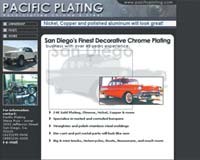Dot-Commentary: Design for Usability
One of the things that I love about the Internet is that anybody with a computer and a modem or a library card can use it.
One of the things that I love about the Internet is that anybody with a computer and a modem or a library card can use it. I remember the emotional charge that I got a couple of months ago when I received an e-mail from a family friend, an 83 year-old woman who never got her driver's license and refuses to go near her VCR. To discover that she was sending and receiving e-mail brought a tear to my eye.
Unfortunately, with the good comes some bad. Thanks to an expanded awareness of HTML and JavaScripts, and the popularity of WYSIWYG ("What you see is what you get") editors, more people are building web sites every day.
But with that influx of cyber-settlers, there has been an alarming increase in the number of poorly designed web sites out there. We've all seen them—flashing graphics, hot-pink backgrounds, dancing gophers, and broken navigation links represent some of the very worst that the Internet has to offer. And it's not just the do-it-yourselfers who are guilty of bad site design. Last year, online retail sportswear company Boo.com amassed over $125 million in financing and then went belly-up. Its demise was due in good part to a complicated interface that drove away frustrated potential customers. Here's a refresher course on some basic principles of web design that will ensure that you don't end up like Boo.com.
Location, Location, Location— Many of us are taught as children to read from left to right, top to bottom. So it's only natural that when a user logs on to your site, their eye is drawn to the top-left corner of the screen. Make sure that the navigation menu resides in the general area (either horizontally along the top of the screen or vertically down the left-hand side) so that users don't have to hunt for it.
When it's not practical or possible to run your navigation along the top or left hand-side of the screen, display it so that it is conspicuous enough to grab the user's attention.
Keep Navigation Simple—The only thing worse than not being able to find a navigation menu is finding one that is clumsy or restrictive. It's very tempting to dazzle users with Flash and JavaScripts, but be cautious of putting style ahead of substance. Bells and whistles are great when they work, but I'll take working HTML any day over a malfunctioning JavaScript.
Minimize User Workload—Provide users with one-click or even zero-click access to your site's most important content. In many cases, this means posting key information on the main page. Splash pages can be neat to look at, but remember that in doing so, you're putting one more obstacle in between the user and the content you want them to see.
Remember Your Users' Limitations—Sure, that three-minute long Flash introduction looks marvelous and runs beautifully over your company's high-speed connection, but what about the prospective customer who is viewing your site over a 56K modem? Web users, in general, are neither terribly patient nor very forgiving. When they run into trouble accessing your content, don't be surprised to hear them say, "Buh-bye" (right before they turn their attention to one of your competitors).
LISTEN to Your Users—You might think that your site is the greatest thing since sliced cheese. The boss loves it, and your co-workers have all given you big kudos. But what are your customers thinking? You really won't know until you've seen it through their eyes. Sit down with a customer and ask them to perform certain tasks on your site. Observe their approach to these tasks and take copious notes. Resist the temptation to walk them through the site or defend it when they are critical of it. Just LISTEN and OBSERVE. I guarantee that by the time you're finished, you will have learned a thing or two about your site's degree of usability.
Read Next
Episode 45: An Interview with Chandler Mancuso, MacDermid Envio Solutions
Chandler Mancuso, technical director with MacDermid Envio discusses updating your wastewater treatment system and implementing materials recycling solutions to increase efficiencies, control costs and reduce environmental impact.
Read MoreA ‘Clean’ Agenda Offers Unique Presentations in Chicago
The 2024 Parts Cleaning Conference, co-located with the International Manufacturing Technology Show, includes presentations by several speakers who are new to the conference and topics that have not been covered in past editions of this event.
Read MoreDelivering Increased Benefits to Greenhouse Films
Baystar's Borstar technology is helping customers deliver better, more reliable production methods to greenhouse agriculture.
Read More















.jpg;maxWidth=300;quality=90)








